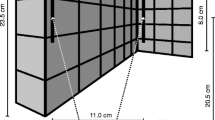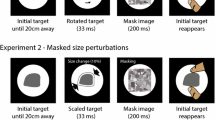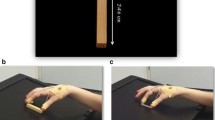Abstract
We examined the effect on manual prehension of introducing a 5-s delay between viewing a target object and initiating a grasping movement. Subjects were tested in four conditions: three involved grasping the object and a fourth involved estimating its size. In the main experimental condition (Open Loop Delay), subjects viewed a target object for 300 ms, but did not initiate a grasping movement until an auditory signal was presented 5 s later. In this condition, subjects had to rely on stored visual information for guiding their grasp after the delay. In another condition (Open Loop), subjects initiated their grasping movement as soon as the target appeared. In both of these open-loop conditions, subjects reached out and grasped the object without seeing their hand. In the third grasping condition (Closed Loop), the target object and the hand were visible throughout the reach. In the three grasping conditions, subjects were instructed to pick up the object across its width using their index finger and thumb. In a final condition (Perceptual Estimation), subjects gave a manual estimate of the object’s width with their index finger and thumb after viewing the object for 300 ms. In all four conditions, subjects were presented with a target object in which the height, length and width were independently varied from trial to trial. The results of the experiment indicated that reaching and grasping movements made in the Open-Loop and Closed-Loop conditions did not differ in any kinematic measures. In contrast, when subjects performed in the Open-Loop Delay condition, their reaches took significantly longer and achieved peak velocity proportionately earlier. As well, their maximum grip aperture was significantly larger. In addition, reaching movements in all three grasping conditions were affected by both the object’s width (the ’relevant’ dimension) and height. The manual estimates in the Perceptual-Estimation condition, however, reflected only the object’s width. These results, together with evidence from other studies, suggest that motor actions performed after a delay use different transformations than those used for ’real-time’ grasping. We argue that the stored visual information used to drive delayed actions arises from a perceptual rather than a visuomotor analysis of the target object.
Similar content being viewed by others
Author information
Authors and Affiliations
Additional information
Received: 10 July 1998 / Accepted: 4 December 1998
Rights and permissions
About this article
Cite this article
Hu, Y., Eagleson, R. & Goodale, M. The effects of delay on the kinematics of grasping. Exp Brain Res 126, 109–116 (1999). https://doi.org/10.1007/s002210050720
Issue Date:
DOI: https://doi.org/10.1007/s002210050720




